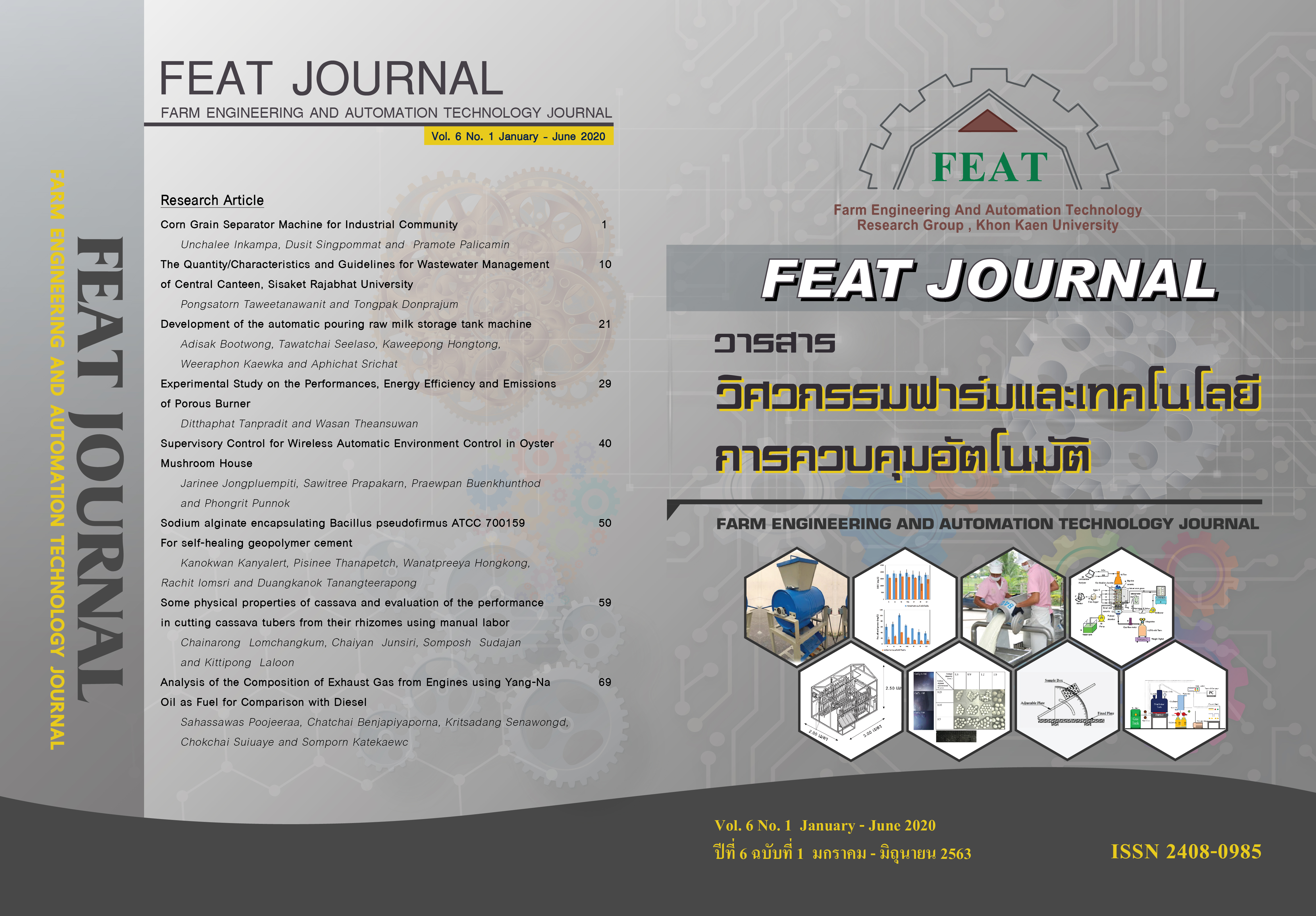Experimental Study on the Performances, Energy Efficiency and Emissions of Porous Burner
Main Article Content
บทคัดย่อ
This research is to experimentally study the performance of a porous burner (PB) and the results are compared with those obtained from the conventional burner (CB). The porous burner consists of two co-concentric cylindrical tubes as a shell and tube heat exchanger. The inside of a tube fills up with spherical ceramics with a diameter of 1.5 cm for forming the porous chamber, which is wrapped around by a larger cylindrical tube as a shell. The shell contains water and serves as a water container. The LPG is used as a fuel and a heat-load condition is set as the gas flow rate of LPG, which is varied in a range of 1 to 7 LPM. Air entrainment is controlled for the excess oxygen between 6-7% in the exhaust. Also, the porosity is a constant of 0.5 and the gas pressure keeps constant at 0.4 bar. Through analysis and discussion of this study, the interesting findings can be drawn as follows: 1) the combustion temperature of the PB is 30% higher than that of the CB on average, while the exhaust gas temperature of the PB is 19% lower than that of the CB on average. 2) Based on the efficiency evaluation, the latent energy, the rate of vaporization, and thermal efficiency obtained by the PB are higher than those obtained by the CB with a value of 46%, 56%, and 48.7% respectively. 3) The maximum energy saving of the PB is higher than that of the CB as much as 21%. 4) very low CO emissions are noticed for both types at high loads, while the NOx emission of the PB is 75% lower than that of the CB and the NOx emission of the PB is lower a 20-ppm limit for all load conditions.
Article Details
วารสารวิศวกรรมฟาร์มและเทคโนโลยีควบคุมอัตโนมัติ (FEAT Journal) มีกําหนดออกเป็นราย 6 เดือน คือ มกราคม - มิถุนายน และ กรกฎาคม - ธันวาคม ของทุกปี จัดพิมพ์โดยกลุ่มวิจัยวิศวกรรมฟาร์มและเทคโนโลยีควบคุมอัตโนมัติ คณะวิศวกรรมศาสตร์มหาวิทยาลัยขอนแก่น เพื่อเป็นการส่งเสริมและเผยแพร่ความรู้ ผลงานทางวิชาการ งานวิจัยทางด้านวิศวกรรมศาสตร์และเทคโนโลยีพร้อมทั้งยังจัดส่ง เผยแพร่ตามสถาบันการศึกษาต่างๆ ในประเทศด้วย บทความที่ตีพิมพ์ลงในวารสาร FEAT ทุกบทความนั้นจะต้องผ่านความเห็นชอบจากผู้ทรงคุณวุฒิในสาขาที่เกี่ยวข้องและสงวนสิทธิ์ ตาม พ.ร.บ. ลิขสิทธิ์ พ.ศ. 2535
เอกสารอ้างอิง
Howell J, Hall M, Ellzey J. “Combustion of Hydrocarbon Fuels within Porous Inert Media”, Progress Energy and Combustion Science, Volume 22, Issue 2, pp.121-145,1996.
Pantangi V, Mishra S. “Combustion of Gaseous Hydrocarbon Fuels within Porous Media – A Review”, Advances in Energy Research, 2006.
Trimis D, Wawrizinek K, Krieger R, Schneider H. “A highly efficient porous radiant burner for industrial applications”, Presented at the Sixth European Conference on Industrial Boilers, 2-5 April, 2002.
Liu J, Hsieh W. “Experimental Investigation of Combustion in Porous Heating Burner”, Combustion and Flame, Volume 138, pp 295-303, 2004.
Wood S, Harris A. “Porous burners for lean-burn applications”, Progress in Energy and Combustion Science 34, pp. 667-684, 2008.
Akbari M, Riahi P, Roohi R. “Lean flammability limits for stable performance with a porous burner”, Applied Energy 86, pp. 2635-2643, 2009.
Chu J, Cheng L, Shi Z, Luo Z, Cen K. “Experimental Research on a Porous Media Gas-Fired Boiler”, Journal of Combustion Science and Technology, 2009-01.
Barcellos W, Souza L, Saveliev A, Kennedy L. “Ultra-low-emission steam boiler constituted of reciprocal flowporous burner”, Experimental Thermal and Fluid Science, Volume 35, Issue 3, pp. 570-580, 2011.
Sumrerng J, Viriya N. “Cyclic Operation of Porous Combustor-heater (PCH)”, Fuel 88, pp 553 – 559, 2009.
Aekkaphon C, Usa M, Sumrerng J. “Self-aspirating/air-preheating porous medium gas burner”, Applied Thermal Engineering 153, pp 181 – 189, 2019


